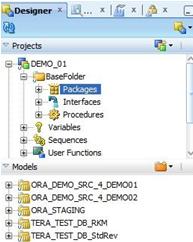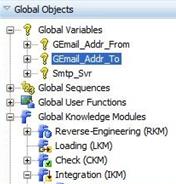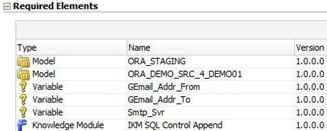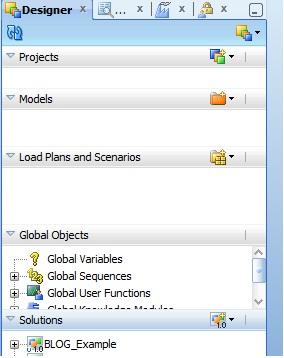|
||||
|
||||
|
In ODI 11g ... the "Solution" feature further leveraged the ODI versioning feature that enabled a developer keeping copies of specific objects like "procedure", "variable" as a "version" object (kept in a table of the Master repository) independently of any other related object in the Work Repository. |
Fig.03. Solution (creating a new container) |
|||
| The Solution container is eventually built as a set of version objects (re-used when they already exist and are current, created when missing in the Master repository table) for all objects (in case of a Project : Interfaces, Procedures, ...) belonging to the main object (Principal Element) dragged and dropped in the "Solution" container and to the related objects of the Principal Element (shared Models, Variables, ...) |
Fig.04 Solution container named Blog_Example |
|||
|
||||
|
Once, the "Solution" has been assembled, it may be shared between all the Work Repositories bound to the (same) Master Repository wherein the version objects have been collected.
In Fig.07, we see a brand new created work repository, still empty. Though, we see the "solution" in the Designer Navigator. The "Solutions" objects are in fact an exception in this GUI sub-part (their specifications are stored in the Master Repository) since specifications of all other objects visible in the Designer Navigator are stored in a Work Repository. .
A usual situation will then be to reverse the 'archived' source of a project into an empty Work Repository in order to bring a 'hot fix' to the code. The developer import the source code from the Master in this empty Work Repository for the purpose.
It is also possible to export a solution into an xml file. In the next post, we will see how it goes with Smart Export-Import ... I must admit now my favorite! |
Fig.07 a 'target' empty Work repository ready for HotFixing |
|||
|
|
||||
|
||||
to share Info, ideas, thoughts over IT and Business related matters such as Project Management, Data Quality, ELT-(L) tools (ODI, ...)...
Thursday, 7 November 2013
ODI11g - A silent evolution in Version Management? (2/3) - Using "Solutions"
Subscribe to:
Post Comments (Atom)







No comments:
Post a Comment